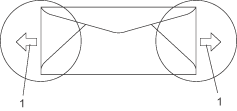| • | Envelopes should have a lengthwise sealing flap. |
| • | The sealing flaps should be folded crisply and correctly (irregularly cut or folded envelopes may cause paper jams). |
| • | Envelopes should have two layers of paper in the areas circled below. |

| • | Before you print envelopes, you must ‘fan’ the stack to avoid paper jams and misfeeds. |
| • | Before you print a lot of envelopes, test one to make sure that the print results are what you want. |
| • | Envelope joints that are sealed by the manufacturer should be secure. |
| • | DO NOT put different types of paper in the paper tray at the same time because it may cause paper jams or misfeeds. |
| • | For correct printing, you must choose the same paper size from your software application as the paper in the tray. |
| • | We recommend that you do not print within 15 mm of the edges of the envelopes. |
| • |
DO NOT use envelopes:
If you use any of the types of envelopes listed above, they may damage your machine. This damage is not covered under any Brother warranty or service agreement. Occasionally you may experience paper feed problems caused by the thickness, size and flap shape of the envelopes you are using. |